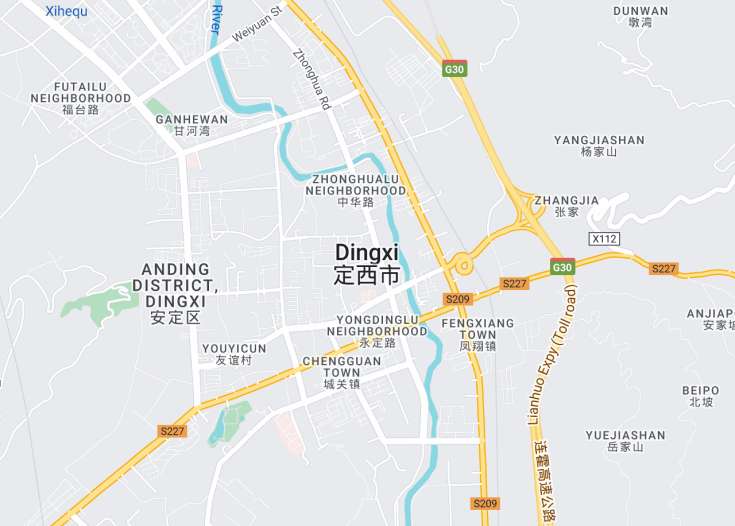Dingxi, located in the central part of Gansu Province, China, is a region steeped in history and natural beauty. Known primarily for its agriculture, Dingxi is dubbed the ‘Potato City’ for being one of the largest potato producers in China. The area is characterized by its rugged terrain including the Loess Plateau and parts of the Yellow River. For history enthusiasts, Dingxi offers ancient sites dating back to the Neolithic era. The region’s commitment to preserving its ecological environment also makes it a perfect destination for nature lovers and those interested in sustainable agricultural practices.
Travelers should consider visiting during the fall harvest season to experience local festivals and enjoy fresh agricultural products directly from the source.
For those planning a trip, packing durable walking shoes is advisable as exploring the rural terrains and historical sites often involves substantial walking.
Top things to do & see in Dingxi
Select the following sights and activities to discover best tickets and tours available in Dingxi.
Dingxi: The Hidden Highland
| Country | China |
| Time in Dingxi | GMT+8 |
| Language spoken | Mandarin Chinese |
| Population | 2.7 million (2021 Census data) |
| Currency | Chinese Yuan (CNY ¥) |
| Airports |
|
Dingxi, a city in the central Gansu province of China, often stands unnoticed despite its rich history and cultural significance. Known as the “Potato Capital of China,” Dingxi serves as a central hub for potato cultivation in the nation, which proves vital for both food security and economic development. Beyond agriculture, Dingxi is celebrated for its unique cultural tapestry, woven from a mix of Han Chinese traditions and influences from the Hui minority. The city’s history dates back to ancient times, being strategically important during multiple dynastic periods in China due to its location on historical trade routes.
Where is Dingxi?
Located in the southeastern part of Gansu province, Dingxi acts as a bridge between the arid plateaus of northern China and the fertile lands of the central region.
Distances:
| Route | Distance by car | Time by car |
|---|---|---|
| Lanzhou to Dingxi | 149 miles | 3 hours 20 minutes |
| Xi’an to Dingxi | 400 miles | 7 hours |
| Tianshui to Dingxi | 130 miles | 2 hours 45 minutes |
What is Dingxi famous for?
Dingxi is renowned for its agricultural prominence, particularly in potato farming, which has become a cornerstone of both local cuisine and economy. Additionally, its historical sites and scenic landscapes make it a compelling destination for those interested in China’s rich past and beautiful natural environments.
History
Prehistoric Times to Han Dynasty (Before 202 BC)
The region now known as Dingxi, located in Gansu province, China, has been inhabited since prehistoric times. Archaeological findings suggest that early human activities were present in this area, capitalizing on its fertile lands and favorable climate. As civilization progressed, Dingxi became part of the territories influenced by the various dynasties that ruled China, including the Qin Dynasty which first unified the country in 221 BC.
Sui to Qing Dynasty (581 AD – 1912 AD)
During the Sui and Tang dynasties, Dingxi’s importance grew due to its strategic location along significant trade routes. This period marked an era of development and cultural exchange. By the time of the Ming and Qing dynasties, Dingxi had established itself as a vital agricultural hub, fostering the growth of communities around farming and trade. The local governance evolved, providing structure and resources to the burgeoning populations.
Republican Era to Present Day (1912 – Today)
The 20th century brought significant changes with the fall of the Qing Dynasty and the rise of the Republic of China. During this period, Dingxi experienced modernization efforts, albeit slower compared to coastal cities. In recent decades, urbanization and development have picked up pace, transforming it into a city that balances modernity and tradition. Today, Dingxi is known for its agricultural produce, particularly potatoes and medicinal herbs, contributing significantly to the regional economy.
Visit Dingxi
What to see and do in Dingxi, China.
Dingxi offers a unique blend of natural beauty and cultural heritage. Visitors can explore Weiyuan Fort, a historical site dating back to the Ming Dynasty, or delve into the natural wonders of the Jingning Grasslands. For those interested in cultural experiences, the local museums display artifacts and exhibitions on regional history and agriculture. Outdoor enthusiasts will appreciate the hiking opportunities in the nearby Qilian Mountains.
- Weiyuan Fort
- Jingning Grasslands
- Local museums and cultural centers
- Hiking in Qilian Mountains
Festivals and Events in Dingxi
Dingxi is vibrant with cultural festivals and events throughout the year. The Dingxi Potato Festival, held every July, celebrates the region’s staple crop with activities, food stalls, and exhibitions. In September, the Qilian Mountain Grassland Festival showcases traditional music, dance performances, and sporting competitions, drawing visitors and locals alike to celebrate the rich pastoral culture.
Best time to visit Dingxi
The best time to visit Dingxi is from May to October when the weather is mild and most suitable for outdoor activities and experiencing local festivals. The landscapes are particularly vibrant during these months, providing picturesque settings for photography and nature walks.
Is Dingxi worth visiting?
Dingxi offers a compelling blend of natural landscapes and rich cultural history, making it a worthwhile destination for those interested in rural China’s heritage and natural beauty. While it might not boast the grandeur of major Chinese cities, its cultural festivals and beautiful grasslands present a charming retreat from the urban bustle. However, potential visitors should be prepared for less developed tourist infrastructure compared to more popular destinations.










